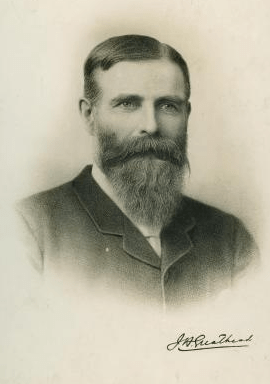James Henry Greathead facts for kids
Quick facts for kids
James Henry Greathead
|
|
|---|---|

James Henry Greathead
|
|
| Born | 6 August 1844 Grahamstown, South Africa
|
| Died | 21 October 1896 (aged 52) Streatham, London
|
| Nationality | British Overseas National (Cape Colony) |
| Education | St Andrews College, Diocesan College, Grahamstown, Cape Town, South Africa; in 1859 he came to Westbourne Collegiate, part of King's College, London. |
| Occupation | Engineer |
| Spouse(s) | Blanche Emily Caldecott Coryndon |
| Children | John Coryndon, James Henry, Nancy, Mary Coryndon |
| Parent(s) | James Henry Greathead and Eliza Julia Wright |
| Engineering career | |
| Discipline | Mechanical Engineering, Civil Engineer |
| Institutions | Institution of Mechanical Engineering, Institution of Civil Engineers |
| Practice name | Chief Engineer for City and South London Railways |
| Projects | Tower Subway Blackwall Tunnel Waterloo & City line Liverpool Overhead Railway |
| Significant design | Greathead Shield, Greathead grouting machine, injector hydrant and other patented designs |
| Awards | Elected to the Council of the Institution of Civil Engineers, 1884 |
James Henry Greathead (born August 6, 1844 – died October 21, 1896) was a brilliant British engineer. He is famous for his important work on the London Underground railways. He also helped build tunnels and railways in other places. His inventions changed how tunnels were built forever. In fact, the London Underground is often called the "Tube" because of a special machine he invented!
Contents
Early Life and Education
James Henry Greathead was born in Grahamstown, South Africa. His family had moved there from England. He went to school in South Africa, first at St. Andrew's College, Grahamstown, and then at Diocesan College in Cape Town.
In 1859, when he was 15, he moved to England. He continued his studies at the Westbourne Collegiate School in London until 1863. After a short trip back to South Africa, he returned to London in 1864. There, he started training with a civil engineer named Peter W. Barlow. This training, called a pupillage, taught him a lot about building tunnels.
Building Tunnels
In 1869, Greathead joined Peter Barlow again to work on the Tower Subway. This was only the second tunnel ever built under the River Thames in central London. Greathead was in charge of actually digging the tunnel.
He became the main builder for the Tower Subway. During this project, Greathead designed and patented his own special tunnelling shield. This shield was a huge improvement for digging tunnels safely and quickly. He also worked as a consulting engineer for the Blackwall Tunnel, helping to design and oversee its construction.
Designing Railways
Greathead also played a big role in building railways. From 1873, he worked as an engineer on the Hammersmith extension railway and the Richmond extension of the District Railway. He held this job for four years.
In 1884, he started working on tunnels again for the London (City) & Southwark Subway. This later became the City & South London Railway, which is now part of the Northern line. When it opened in 1890, it was the world's first underground electric railway!
He also worked on the Liverpool Overhead Railway and the Waterloo & City line. His last project was the Central London Railway.
Amazing Inventions
James Greathead was a true inventor. He created several important tools and methods that changed how tunnels and other structures were built.
The Greathead Shield
The Greathead Shield was a huge invention. It was a strong, cylindrical (tube-shaped) iron machine. It had powerful screw jacks that pushed it forward as workers dug out the earth in front of it. As the shield moved, workers behind it installed strong cast iron segments to create the tunnel walls. This made tunnelling much safer and faster.
Greathead also added other smart ideas to his shield. He used compressed air inside the tunnel to help keep workers safe, especially when digging under water. He also invented a way to spray cement grout (a special liquid cement) behind the tunnel lining. This grout would fill any gaps and make the tunnel walls super strong. This method is still used today!
Greathead Injector Hydrant
Around 1879, Greathead invented the Greathead Injector Hydrant. This machine was used to inject the special cement grout behind the cast iron tunnel linings. It made sure the tunnel walls were strong and stable.
Greathead Grouting Machine
His Greathead Grouting Machine was another key invention. It used compressed air to push the grout into cracks and spaces. This machine was so effective that it was even used to help repair famous buildings like Winchester and Lincoln Cathedrals!
Patents and Ideas
Greathead received many patents for his inventions. A patent protects an inventor's ideas. Some of his important patents included:
- A tunnelling shield that used water jets to break up soft ground.
- Improvements to his shield design.
- The grouting pan for injecting cement.
- A shield with a spinning cutter to dig through earth.
- Improvements for railway car parts.
He even discovered that concrete could be sprayed onto surfaces to make them strong. This idea led to shotcrete or spray cement, which is used a lot in construction today.
Honours and Memorials
James Henry Greathead's amazing work is remembered in several ways:
- A special blue plaque marks his home in Barnes, where he lived from 1885 to 1889.
- In January 1994, a statue of Greathead was put up outside Bank station in the City of London. It stands on a base that cleverly hides a ventilation shaft for the Underground.
- During renovations at Bank Station, a piece of his original Greathead shield was found! It has been painted red and has a brass plate explaining its importance. It's a great reminder of his achievements.
See also
Images for kids



